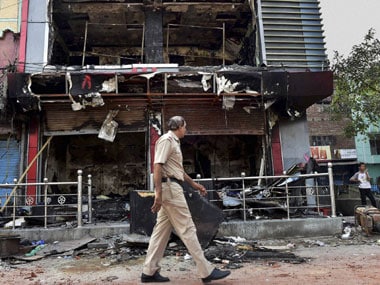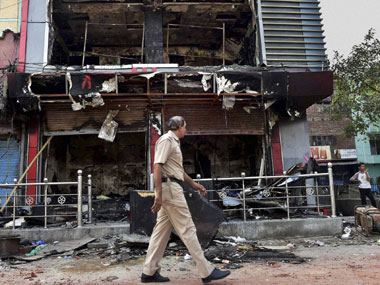New Delhi: After politics over garbage, it’s politics over communal violence. The battle for Delhi is heating up. East Delhi’s Trilokpuri is yet to recover from the shock of the three-day communal tension, but that has not stopped a full-fledged war of words between the big political players in the national capital - the AAP and the BJP - over the development in the last three days. The AAP sees a bigger conspiracy behind the escalation of violence and the apparent delay in police action. The BJP has strongly refuted the allegation. The fact that the bypolls to three seats are due soon and that the assembly election may not be far off make the cynical political games behind the exchange of allegations stand out. “The people of Delhi will not support the riots. The people of India are peace-loving and will never support a communal conflict… It is a pattern – wherever an election or by-election is due, riots are taking place, like the one happened at Muzaffarnagar. After many years, Delhi has witnessed a riot at Trilokpuri,” AAP chief Arvind Kejriwal said on Sunday on a TV channel. He also tweeted a similar message, pointing a finger at the BJP. The AAP MLA from Trilokpuri, Raju Dhingan in his statement has alleged the BJP of flaring up communal tension in the area. [caption id=“attachment_1774675” align=“alignleft” width=“380”]  A police personnel reviews the situation in Trilokpuri. PTI.[/caption] “It’s the BJP that has indulged in creating communal tension at Trilokpuri, which has now taken the shape of a riot. The jurisdiction of Delhi police lies with the central government. So, when the dispute broke out between the two groups, why did the police take so much time to control it? Wasn’t it intentional?” questioned a senior member of AAP. “It’s a clear case of indirectly inciting communal violence by preventing police from taking action at the right time. Now, the Ministry of Home Affairs has sought a report on this. This is an eye-wash. The motive behind this was to malign the AAP, as Trilokpuri MLA is from our party, and thereby take advantage out of this situation,” the member alleged. The communal tension that took the shape of a riot and led to the imposing of Section 144 in the area, triggered from a petty confrontation between the Dalit community and Muslims on Diwali evening. “It was a small altercation between the two groups, which is almost a regular feature in this locality. But a rumour was spread that a Muslim youth urinated at Block 20, which was incorrect. This flared up and got converted into communal tension. Right now it can’t be said that there was any political motive behind this. But, yes, the local MLA, who’s from the AAP has blamed the BJP,” said senior journalist Dinesh Avinashi, a resident of Trilokpuri. This is not the first time that Trilokpuri has witnessed a communal violence. Thirty years ago, during the 1984 Sikh riots, 350 Sikhs were massacred in this locality. On November 1, 1984, a frenzied mob attacked Trilokpuri and 350 Sikhs were dragged out of their homes, some burnt alive and others beaten to death. An account of the 1984 incident is well illustrated in the book titled, ‘Amritsar’ penned by BBC’s then India correspondents Mark Tully and Satish Jacob. “Since then, Trilokpuri hasn’t recovered from that horrifying incident and continues to reel under tension. And, clashes have become a common feature,” added Avinashi. According to the locals, clashes between the two communities took place earlier too, on Independence Day over flying kites and later on Eid. The Dalits comprise nearly 80 percent of the total population of Trilokpuri, which is largely a resettlement colony with slums. The Dalits are followed by OBCs and Muslims. The locality has also become infamous due to thriving social crimes like gambling, bootlegging, theft and hooliganism. “The Congress grossly neglected this area, and it went in favour of AAP. The Congress voters comprising Dalits and OBCs shifted their allegiance to AAP and the party won assembly seat from here. But, after Kejriwal quit Delhi government and joined the race for PM, a major chunk of AAP’s vote bank shifted to the BJP during the Lok Sabha polls. Now, this blame game could be AAP’s ploy to win back its voters,” analysed AAP’s former national executive member Surojit Dasgupta. “No single factor can be attributed to this communal riot,” he added. In the context of this spate of violence, a rumour is doing the rounds that to win the minority vote bank, Kejriwal had reportedly met members of All India Majlis-e-Ittehadul Muslimeen (MIM) during their Delhi visit on October 22. The rumour is abuzz on Twitter as well. “Probably, Kejriwal had met MIM leader Akabaruddin Owaisi. Now, with the Congress largely a non-entity, the AAP is eyeing the space that the former had occupied and so it wants to reach a settlement with the Muslim voters,” a source in the know of political developments in Delhi said. Meanwhile, the BJP has termed statements of Kejriwal and Dhingan as an attempt to polarise voters on communal grounds. “Earlier too, Kejriwal had courted controversy after he approached the Muslim cleric Maulana Tauqeer Raza Khan ahead of the Assembly election to campaign for AAP. The Election Commission had warned Kejriwal for violation of model code of conduct, when he distributed pamphlets seeking Muslim votes. Now he’s trying to create sensation by accusing the BJP on Trilokpuri riot issue,” said state BJP spokesperson Harish Khurana.
After politics over garbage, it’s politics over communal violence.
Advertisement
End of Article


)

)
)
)
)
)
)
)
)



